= Crassula perfoliata var. falcata (J.C.Wendl.) Toelken
J. S. African Bot. 41(2): 115 (1975)
Accepted Scientific Name: Crassula perfoliata var. minor (Haw.) G.D.Rowley
Cact. Succ. J. Gr. Brit. 40(2): 53 (1978)

Larochea falcata (Crassula perfoliata var. falcata) Photo by: Cactus Art
Produces pairs of attractive and interesting sickle shaped grey-green leaves, but a show stopper when the bright red flowers emerge. The flower smells like sweet cinnamon and usually lasts 6-8 weeks.
Sometimes they bloom twice a year, and the bees really love the flowers too.
Origin and Habitat: South Africa from the Cape of Good Hope (Eastern Cape Province)
Synonyms:
See all synonyms of Crassula perfoliata
Common Names include:
ENGLISH: Airplane Plant, Scarlet Paintbrush, Propeller Plant
DANISH (Dansk): Dampskibsskrue
POLISH ( Polski): Grubosz szablasty
Description: Crassula perfoliataSN|11182]]SN|11170]] var. falcata (The 'Propeller Plant' or 'Airplane plant') make a lovely clump/low growing shrub, that usually grows less than 60 cm tall (but some sources say 1.2 m of height). It has very peculiar grey-green sickle-shaped leaves that are arranged in overlapping pairs along a usually unbranched stem. Tiny scarlet red flowers are massed together in very showy dense clusters that rise above foliage in mid summer. The flowers open slowly and last for nearly a month when in full bloom. Another common name used for this plant is Scarlet Paintbrush, refering to the beautiful flowers.
Stem: Usually unbranched above (but forming new shoots at the base), succulent becoming woody in age.
Roots: Fibrous.
Leaves: Interesting glaucous grey-green arranged in overlapping pairs, leaves are propeller shaped (sickle shaped), decussate, ascending, becoming spreading, lanceolate, slightly falcate, smooth, upper face flat, channelled at the base, margins acute toward the apex, truncate lower down, lower face convex, tip recurved and acute, mucronate up to 10 cm long, 2-3 cm wide. These leaves radiate outward in opposite directions like wings, which gives the plant the common name "Airplane Plant".
Flowers: Spectacular clusters of tiny bright orange-red or scarlet-red florets arranged in dense cymes, that rise above foliage. Flower heads grow 8 to 12 cm wide and are scented.
Blooming season: Flowers starts to develop in June and are in full bloom in August. The flowers open slowly and last for nearly a month when in full bloom.
Taxonomy: This plant, long grown as Rochea falcataSN|11184]]SN|11184]] and then Crassula falcataSN|11170]]SN|11182]] is now correctly named Crassula perfoliataSN|11182]]SN|11170]] var. minor though in cultivation it continue to be listed is a Crassula falcataSN|11170]]SN|11182]] as this name is better recognized.
Subspecies, varieties, forms and cultivars of plants belonging to the Crassula perfoliata group
 Crassula perfoliata L.: (var. perfoliata) is little branched up to 1.3 m high, with lanceolate leaves erect and channelled above. The flowers are small, white and appear in the summer. Distribution: north of Port Elizabeth to Graaff-Reinet and Willowmore.
Crassula perfoliata L.: (var. perfoliata) is little branched up to 1.3 m high, with lanceolate leaves erect and channelled above. The flowers are small, white and appear in the summer. Distribution: north of Port Elizabeth to Graaff-Reinet and Willowmore. - Crassula perfoliata var. coccinea (Sweet) G.D.Rowley: has the red, larger flowers but its leaves are lanceolate-triangular, canaliculate and erect to spreading. Distribution: river valleys between Port Elizabeth and King William's Town.
 Crassula perfoliata var. falcata (J.C.Wendl.) Toelken: (syn: Crassula perfoliata var. minor) has very peculiar grey-green sickle-shaped leaves that are arranged in overlapping pairs along a usually unbranched stem. Flowers are bright red. Distribution: Eastern Cape.
Crassula perfoliata var. falcata (J.C.Wendl.) Toelken: (syn: Crassula perfoliata var. minor) has very peculiar grey-green sickle-shaped leaves that are arranged in overlapping pairs along a usually unbranched stem. Flowers are bright red. Distribution: Eastern Cape.- Crassula perfoliata var. heterotricha (Schinz) Toelken: is smaller (40 cm tall) and branched with erect leaves, has small white flowers appearing in the winter. Distribution: Umtata northwards through KwaZulu-Natal and Transvaal to south-east tropical Africa.
- Crassula perfoliata var. minor (Haw.) G.D.Rowley: is 20-50 cm tall and is rarely branched. The leaves are laterally flattened, falcate, greyish, has larger bright red flowers (rarely , pink or white). Distribution: Willowmore to East London, and north of the Kei River.
Bibliography: Major references and further lectures
1) Forest & Kim Starr “Crassula perfoliata var. falcata (propeller plant, red crassula)”. Plants of Hawaii. <http://www.starrenvironmental.com>. Web. 27 Sep. 2014.
2) Doreen Court “Succulent Flora of Southern Africa” CRC Press, 01/giu/2000
3) Stuart Max Walters “The European Garden Flora: Dicotyledons” (Part I) Cambridge University Press, 1989
4) Gordon D. Rowley “The illustrated encyclopedia of succulents” Crown Publishers, 01/Aug/1978
5) Eggli, Urs “Illustrated Handbook of Succulent Plants, Crassulaceae Illustrated Handbook of Succulent Plants.” Springer, Berlin 2002
6) Hermann Jacobsen “Abromeitiella to Euphorbia” Blandford Press, 1960
7) Hermann Jacobsen “A handbook of succulent plants: descriptions, synonyms, and cultural details for succulents other than Cactaceae” Volume 1 Blandford Press, 1960
8) Toelken, H.R. 1997. “A revision of the genus Crassula” in southern Africa. Annals of the Bolus Herbarium 8,1-595.
9) Dr J.P. Roux “Flora of South Africa” 2003
10) Van Jaarsveld, E., Van Wyk, B-E. & Smith, G. “Succulents of South Africa.” Tafelberg, Cape Town. 2000
11) John Manning “Field Guide to Fynbos” Struik, 2007
12) Vera Higgins “Succulent Plants Illustrated” Blandford Press, 1949
13) Leistner, O.A. “Seed plants of southern Africa: families and genera” Strelitzia 10. National Botanical Institute, Pretori
14) Werner Rauh “The Wonderful World of Succulents: Cultivation and Description of Selected Succulent Plants Other Than Cacti” Smithsonian Institution Press, 1984
16) Smith, C.A. “Common Names of South African Plants.” Dept. of Agricultural Technical Services, Botanical Survey Memoir No 35, Government Printer. 1966
17) San Marcos Growers contributors “Crassula falcata - Airplane plant. San Marcos Growers <http://www.smgrowers.com>. Web. 27 Sep. 2014.
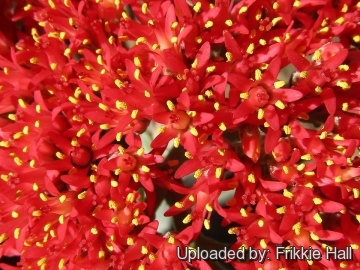 Crassula perfoliata var. falcata (Propeller Plant) flower close-up. (Crassula perfoliata var. falcata) Photo by: Frikkie Hall
Crassula perfoliata var. falcata (Propeller Plant) flower close-up. (Crassula perfoliata var. falcata) Photo by: Frikkie Hall Larochea falcata (Crassula perfoliata var. falcata) Photo by: Andrea B.
Larochea falcata (Crassula perfoliata var. falcata) Photo by: Andrea B.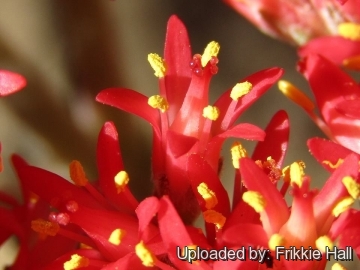 Larochea falcata (Crassula perfoliata var. falcata) Photo by: Frikkie Hall
Larochea falcata (Crassula perfoliata var. falcata) Photo by: Frikkie Hall - Produces pairs of attractive and interesting sickle shaped grey-green leaves, but a show stopper when the bright red flowers emerge. The flower smells like sweet cinnamon and usually lasts 6-8 weeks.
Sometimes they bloom twice a year, and the bees really love the flowers too. (Crassula perfoliata var. falcata) Photo by: Cactus Art
- Produces pairs of attractive and interesting sickle shaped grey-green leaves, but a show stopper when the bright red flowers emerge. The flower smells like sweet cinnamon and usually lasts 6-8 weeks.
Sometimes they bloom twice a year, and the bees really love the flowers too. (Crassula perfoliata var. falcata) Photo by: Cactus Art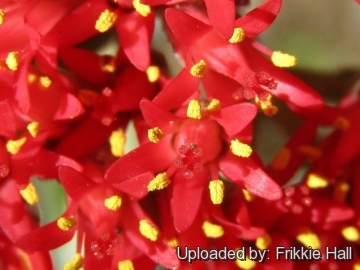 Larochea falcata (Crassula perfoliata var. falcata) Photo by: Frikkie Hall
Larochea falcata (Crassula perfoliata var. falcata) Photo by: Frikkie Hall It produces spectacular clusters of bright orange-red flowers arranged in dense cymes. (Crassula perfoliata var. falcata) Photo by: Frikkie Hall
It produces spectacular clusters of bright orange-red flowers arranged in dense cymes. (Crassula perfoliata var. falcata) Photo by: Frikkie Hall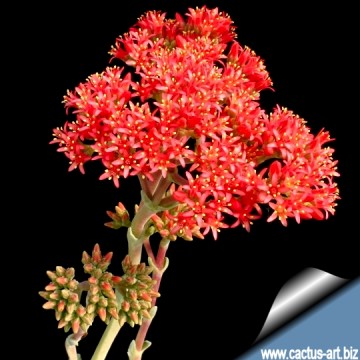 Flowers develop in June (In Europe) and are in full bloom in August. Flower heads grow 8 to 12cm wide. (Crassula perfoliata var. falcata) Photo by: Cactus Art
Flowers develop in June (In Europe) and are in full bloom in August. Flower heads grow 8 to 12cm wide. (Crassula perfoliata var. falcata) Photo by: Cactus Art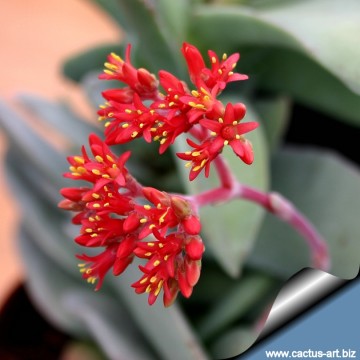 Larochea falcata (Crassula perfoliata var. falcata) Photo by: Cactus Art
Larochea falcata (Crassula perfoliata var. falcata) Photo by: Cactus ArtCultivation and Propagation: The Airplane plant is a stunning as a container plant, in decorative pots, in courtyards and rockeries, and especially ideal for mass plantings and borders, where its dramatic foliage and spectacular flower heads are shown to their best effect. Attractive and interesting when not in bloom but a show stopper when the bright red flowers emerge.
Soil: It needs well drained soil (standard cactus potting mix).
Waterings: Requires very little irrigation in coastal gardens, irrigate occasionally in hotter inland climates. In pots needs regular wateringsall year, but reduce watering during winter month and apply a balanced liquid fertilizer during the summer months (June, July, August).
Exposure: It grows well in light shade to full sun.
Hardiness: Protected from frosts, but hardy to -5 C for short periods if very dry.
Maintenance: Remove spent flower heads to maintain vigour and bushy habit.
After growing for several years tend to become untidy, and should be cut very short or restarted from cuttings.
Pests & Disease: Aphids, mealy bugs, powdery mildew, fungal leaf spot, stem and root rot if over watered.
Propagation: Leaf or stem cuttings in spring or summer.
Your Photos

by Cactus Art

by Forest Starr & Kim Starr
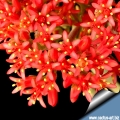
by Cactus Art
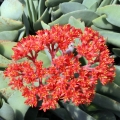
by Valentino Vallicelli






















